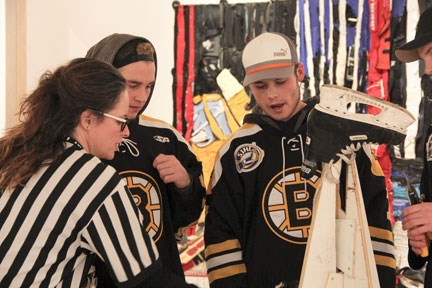In anticipation of the 2014 Winter Olympics in Sochi, the Estevan Art Gallery and Museum is presenting the city's art goers with the artistic side of sport.
Opening on Jan. 16 in Gallery 1 was Liz Pead's Breaking the Ice, which features the Canadian artist's signature use of used and recycled hockey equipment to depict sweeping landscapes and vistas.
The pieces in the gallery reflect wilderness works of the Group of Seven as well as dramatic events in Canada's history. At the EAGM, Pead displays Louis Riel's surrender at Batoche and a colourful depiction of the wreckage of the plane crash site, which claimed the life of Bill Barilko, a member of the Toronto Maple Leafs in the 1940s and 50s.
These scenes are all meticulously crafted with what Pead calls "truly Canadian material:" hockey equipment.
"I wanted to learn how to paint like Tom Thomson, and I wanted to learn how to paint like Gordon Harrison. I worked really hard and I got kind of close, but then I got to a point when I had to develop my own body of work, and I wanted to find a truly Canadian material to make it from, and I landed on hockey gear," she Pead while attending the EAGM last week.
Pead is a native of New Brunswick but now lives in Toronto where she plays hockey in a recreational womens' league when she isn't producing art with old equipment.
"Finding a truly Canadian material to make my large-scale installation painting works led me to broken hockey gear. Not only abundant in arena garbage cans all across this great nation - diverting hockey gear from the ignoble landfill to landscape art satisfies my vague Canadian sense of environmental guilt," Pead writes in her blog. "Putting up trees made from the broken bits of hockey sticks is not without a good dose of Canadian self-deprecating humour. That we read them as trees first and recycled gear later plays the joke on us."
Pead said she was inspired by Barilko's story. He was the Maple Leaf who scored a game-winning goal to win the Leafs a Stanley Cup in 1951, only to disappear that summer. The site of the crash wasn't found, and what happened to Barilko wasn't known until 1962, a month after the Maple Leafs won the Stanley Cup for the first time since Barilko's hallowed goal.
"The curse was lifted and all was well in Maple Leaf land after that," Pead said. "For me, that was an intersection of landscape and hockey in a very interesting way."
Another piece in the exhibit bares a similar combination of quiet landscape and tragedy, as she depicts the death of Tom Thomson, a Canadian painter who died in 1917.
"This is the site in Canoe Lake in Algonquin, Ontario, where he drowned mysteriously," she said referring to another collection of colourful hockey equipment. "They found his canoe a few days later, and there's a lot of mystery surrounding his death. Where was he buried? Did somebody kill him? Nobody knows."
The Louis Riel piece is one of her newest creations and was inspired by a graphic novel by Chester Brown.
Her piece includes a lot of snow, made entirely of sweat-stained pads.
"The effects of sweat, the effects of hockey, that's what it did to that equipment. I think that's kind of cool to get that variation," she said of the snow-covered landscape.
Pead has a background in textiles and that played a big role in her use of equipment to create what she still considers to be painting.
"For many, many years people said 'Oh no, no, no, you're doing textile art.' No, it's a painting," she said. "It's very much in the language of painting, but at the same time, I want it to be fun and accessible."
Pead also has some experience in Iceland, having spent time in the country on a number of occasions. She noted a Russian man there is helping to revitalize the womens' hockey program in and when she mentioned her hockey-equipment based art, he lit up and wanted pieces for all the arenas in Iceland he was involved with.
Her pieces are to remain on display in a number of Icelandic arenas.
A group of players from the CanElson Drilling Estevan Bruins junior A team received a lesson from Pead in sculpting last week, just prior to the exhibits opening. Donning a referee's jersey, Pead oversaw the hockey players' projects as they sculpted trees from her medium of choice, used hockey equipment.
The exhibit runs until Feb. 28.



